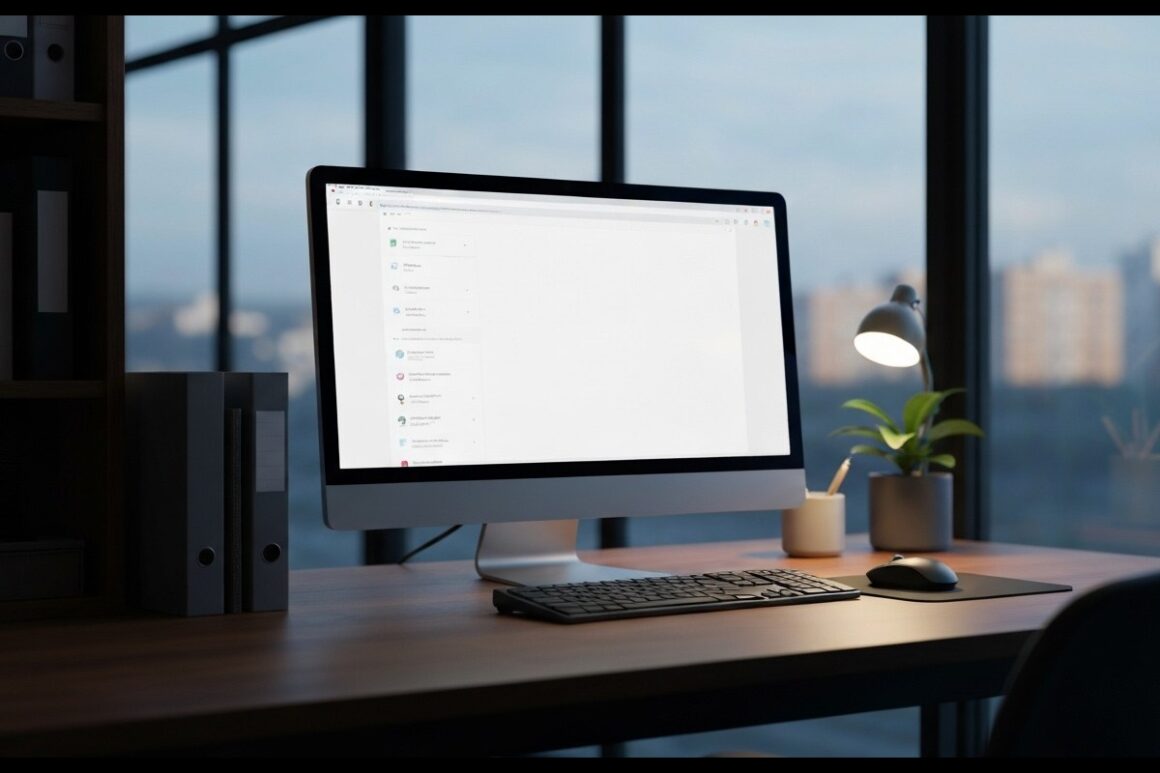Table of Contents
Key Highlights
- The about:blank page is a built-in, intentionally blank page found in most web browsers like Chrome and Firefox.
- It is not malware or a virus but can sometimes appear as a symptom of an underlying security issue or loading error.
- Common causes for its appearance include network problems, incorrect URLs, or security software blocking a malicious site.
- You can manage about:blank by changing your browser’s homepage settings, but you cannot remove the feature entirely.
- Setting about:blank as your homepage can be a useful tool for faster browsing, increased privacy, and fewer distractions.
Introduction
Have you ever opened a new tab or clicked a link, only to be met with a stark white page and “about:blank” in the address bar? This common occurrence in your browser window can be confusing, but it’s usually not a cause for alarm. The about:blank page is a standard feature of your web browser, serving several purposes. This guide will explain what this page is, why it appears, whether it’s safe, and how you can manage or even utilize it.
Understanding About:blank in Web Browsers
The about:blank page is exactly what its name suggests: an intentionally empty page that is a built-in component of your web browser. It is not a website from the internet with a real URL but rather an internal command. Think of it as a neutral, default state for your browser.
When you see this blank page, it simply means the browser has been instructed to display nothing. The “about:” part of the address is a scheme used to access internal browser pages, and “blank” is the specific command to show an empty screen. This feature is a fundamental part of your browser‘s design.
What is the Purpose of About:blank?
When you see “about:blank” in your browser address bar, it means your web browser is displaying an internal, empty page because it wasn’t given any other content to load. It is a placeholder, a blank page that appears when no other URL is specified or can be reached. For example, if you haven’t set a default homepage, your browser might open to about:blank.
The purpose of this page is versatile. Sometimes, security software will redirect you to about:blank to prevent you from landing on a malicious website. This acts as a protective barrier, showing you a safe, empty space instead of harmful content. It effectively stops the browser from proceeding to a risky destination.
Additionally, the page serves a practical function. In many browsers, the address bar on an about:blank page still functions as a search bar. This allows you to start a new search or type in a new web address without first having to load a content-heavy portal or search engine homepage.
How Does About:blank Function Across Different Browsers?
The core function of about:blank is consistent across all major browsers, including Chrome, Firefox, Safari, and Edge. In every case, it commands the browser to load an empty browser window. This makes it a universal feature for modern browsing, ensuring there is always a default, neutral page to display when needed.
While you cannot completely remove or stop the about:blank feature because it’s an integral part of browser architecture, you can control when it appears, such as by setting a different homepage. The “about:” command scheme, however, can vary slightly between browsers, offering access to different internal pages.
Here is a look at some common “about:” commands for different browsers. Note that Safari relies more on keyboard shortcuts than “about:” commands for similar functions.
| Browser | Useful “about:” Commands |
|---|---|
| Chrome | about:downloads, about:history, about:settings |
| Firefox | about:addons, about:config, about:support |
| Edge | about:favorites, about:history, about:settings |
Common Reasons About:blank Pages Appear
Seeing about:blank in your address bar can happen for several reasons, and it’s often the browser‘s response to a specific situation. It can be triggered by anything from technical glitches like loading errors to intentional user settings.
For instance, clicking on certain downloads links that open a new tab to process the file may momentarily show an about:blank page. It also serves as a default fallback when a website’s address is mistyped or the browser encounters a problem that prevents it from rendering the intended content.
Network and Loading Errors Leading to About:blank
One of the most frequent reasons your browser loads about:blank instead of a website is due to connectivity or loading issues. When your browser attempts to access a URL but fails, it may display the blank page as a placeholder in the browser window. This is its way of handling an error gracefully instead of crashing.
These loading errors can stem from various sources. A spotty internet connection can interrupt the communication between your browser and the website’s server. In other cases, the website itself might have bugs in its code or issues with its cache that prevent it from loading correctly for you.
Here are a few specific technical issues that can lead to an about:blank page:
- Poor
networkconnection: Your device may have lost its connection to the internet while the page was trying to load. - Incorrect or broken URL: The link you clicked or the address you typed may be misspelled or lead to a page that no longer exists.
- Browser cache problems: Outdated or corrupted data stored in your browser’s cache can interfere with loading a website properly.
User Settings or Extensions Triggering About:blank
Your own browser configuration is another common reason for encountering the about:blank page. Many of these instances are not errors but are instead the result of specific user settings. If you see about:blank every time you open your browser, it’s likely set as your startup page.
This can be an intentional choice for a minimalist start, or it could be the default setting if you haven’t specified a homepage. Additionally, certain browser extensions or add-ons can interfere with how pages load. An aggressive ad-blocker or a faulty extension might cause a blank page to appear in place of content.
You can stop this behavior by adjusting your settings. Key triggers include:
- No default
homepage: The browser defaults to a blank page if no specific startup page is assigned. - Conflicting
extensions: Too many add-ons running at once can cause loading conflicts. - Security software actions: Some antivirus programs block a suspicious site and display a blank page for your protection.
Is About:blank Safe or a Security Concern?
The about:blank page itself is completely safe. As a built-in browser feature, it contains no code and cannot harm your computer, steal your personal data, or compromise a site password. Its primary purpose is to be an empty, neutral space. The safety of this page is guaranteed by its simplicity.
However, while the page is harmless, its frequent and unexpected appearance could signal an underlying security issue. If your browser is constantly redirecting to about:blank without your command, it might be a symptom of malware manipulating your browser’s behavior. The page isn’t the threat, but it can be a red flag.
Can About:blank Indicate Malware or Viruses?
While about:blank is not malware or a virus, its behavior can sometimes be a sign of a malware infection. Cyber threats like adware or browser hijackers can alter your browser settings without your permission. If your homepage is suddenly changed to about:blank or you experience a barrage of pop-up windows showing this page, it could be a symptom of a problem.
This malicious software often gets on your system through deceptive downloads or by clicking on suspicious links in a phishing email. The malware doesn’t create about:blank, but it uses this built-in page to disrupt your browsing, often by failing to load its intended ads or redirects.
Therefore, you should not be concerned about the page itself, but rather the context in which it appears. If its presence is accompanied by other strange browser behavior, like sluggish performance or unwanted toolbars, it’s wise to run a full scan for viruses and other threats to ensure your device is clean.
Situations When About:blank Is Useful or Harmless
In most everyday scenarios, seeing the about:blank page is completely harmless and you shouldn’t be concerned. It often appears for benign reasons, such as when you open a new tab or click a link that opens in a new window before the content has had a chance to load. This is normal browser behavior.
Furthermore, the page can be quite useful as a security feature. Some antivirus and security software intentionally use about:blank to protect you. If you attempt to visit a website that is flagged as dangerous or containing malware, the software may block it and show you a blank page instead, preventing a potential infection.
This page is also a great tool for users who prefer a minimalist browsing experience. It loads instantly, uses minimal system resources, and provides a clean slate without the distractions of a content-heavy homepage. For this reason, many people choose to set it as their homepage intentionally.
Managing and Removing About:blank Pages
While completely removing the about:blank function from your browser is not possible since it’s a core feature, you can easily manage when and how it appears. If you find it showing up as your homepage or on startup and prefer something else, a simple settings change is all that’s needed.
The goal is to control its behavior rather than eliminate it. By preventing it from being your default page, you can customize your browser to open directly to your favorite search engine, news site, or work portal. The following sections provide clear steps for making this change.
Removing About:blank on Chrome, Firefox, Edge, and Safari
If your browser opens to a blank page and you want to change it, removing about:blank as your startup page is straightforward. The process is slightly different for each browser, but the principle is the same: you need to go into the settings and specify a new homepage or startup page.
This process is simple on desktop versions of Chrome, Firefox, Edge, and Safari. The steps are also similar for mobile browsers on devices like Android, where you can access startup settings through the browser’s main menu.
Here’s how to remove it on major browsers:
- Google
Chrome: Go to Settings > “On startup.” Select “Open a specific page or set of pages” and either removeabout:blankor add a new page. - Mozilla
Firefox: Navigate to Settings > “Home.” Under “Homepage and new windows,” select “Custom URLs…” and replaceabout:blankwith your preferred website. - Microsoft
Edge: Open Settings > “Start, home, and new tabs.” Under “When Edge starts,” choose “Open these pages,” and delete theabout:blankentry.
Preventing About:blank Pop-Ups and Unwanted Behavior
If you are experiencing frequent about:blank pop-ups, this is a form of unwanted behavior that typically points to adware on your system. These pop-ups occur when a malicious ad is blocked by your browser or fails to load its content, leaving a blank window in its place. The solution is not to block about:blank itself but to address the root cause.
To stop these pop-ups, you should first ensure your browser’s built-in pop-up blocker is enabled. This can prevent many intrusive windows from appearing. If the problem persists, it is a strong indication that adware or another form of malware is present on your device.
Here are steps to prevent this unwanted behavior:
- Enable the pop-up blocker: Check your browser’s settings to ensure it is actively blocking pop-up windows.
- Scan for malware: Use a reputable antivirus or anti-malware tool to scan your computer and remove any threats it finds.
- Be cautious with
downloads: Avoid downloading software from untrusted websites, as this is a common way for adware to be installed.
Making Use of About:blank for Productivity
Beyond being a simple error page, about:blank can be intentionally used as a tool to enhance your productivity and privacy. By setting this blank page as your homepage, you can create a focused and efficient start to every browsing session.
Instead of being greeted by a busy news feed or a tempting social media site, your browser window opens to a clean slate. This minimalist approach forces you to be intentional about your next step, whether it’s starting a work task or searching for specific information, thereby minimizing distractions from the very beginning.
Setting About:blank as Your Homepage: Pros and Cons
Choosing about:blank as your default homepage in your browser offers several useful features and benefits, but it’s important to weigh the pros and cons. For many, the advantages make it an attractive option for a cleaner browsing experience.
The primary benefit is speed and simplicity. The page loads instantly since it has no content, making it ideal for older computers, devices with slow internet connections, or when you’re trying to conserve battery life. It also provides a distraction-free environment, helping you focus on the task at hand instead of getting pulled into whatever content your usual homepage displays.
However, there are some downsides to consider:
- Pros: Fast
browserstartup, lower bandwidth usage, and a minimalist, distraction-free starting point. - Cons: Less convenient, as it requires you to manually type a web address or search term for every session.
- Overall: It is a very useful feature for users who prioritize speed and focus over the convenience of a pre-loaded page.
About:blank for Privacy-Focused Browsing
Using about:blank as your homepage is a simple yet effective step toward more privacy-focused browsing. When your browser opens to a specific website, it immediately sends information and may load trackers and cookies from that site. Starting with a blank page avoids this initial data exchange, giving you more control over your digital footprint.
This approach enhances your security by ensuring no external scripts are run upon startup. You are not sending any requests that could reveal information about your browser or location until you decide to navigate to a website. This protects your personal data from being collected by default homepages that monetize user information.
Here are the key privacy benefits:
- No initial tracking: It prevents homepage trackers and cookies from loading automatically when you open your browser.
- Increased intentionality: It forces you to actively choose your first destination, reducing mindless browsing and data exposure.
- Enhanced
security: Starting with a clean, internal page minimizes the risk of loading a compromised homepage.
Conclusion
In summary, the About:blank page serves various purposes in web browsing, from a simple placeholder to a tool for enhancing privacy and productivity. Understanding its function and the reasons it may appear can help alleviate any confusion or concern. Whether due to network errors, user settings, or simply for a fresh start, About:blank can be harmless or even beneficial for users. By managing how your browser handles these pages, you can ensure a smoother browsing experience. If you’re looking to explore more about managing your online presence effectively, consider scheduling a free consultation with our experts today!
Frequently Asked Questions
Why does my browser show about:blank instead of a webpage?
Your browser displays a blank page with about:blank in the address bar due to loading errors, a poor internet connection, or an incorrect URL. It is a default page shown when the browser cannot load the intended website content.
Is the About:blank page connected to any clothing brands or online stores?
The about:blank browser page has no connection to any clothing brand or online stores. The name is a coincidence. Any company using a similar name on the internet is separate from the technical function within your web browser.
Should I be worried if I keep seeing About:blank on my computer?
Occasional appearances of about:blank are normal. However, if it constantly appears as your homepage without you setting it, or in frequent pop-ups, you should be concerned. This could indicate malware, so run a security scan on your computer‘s browser.


